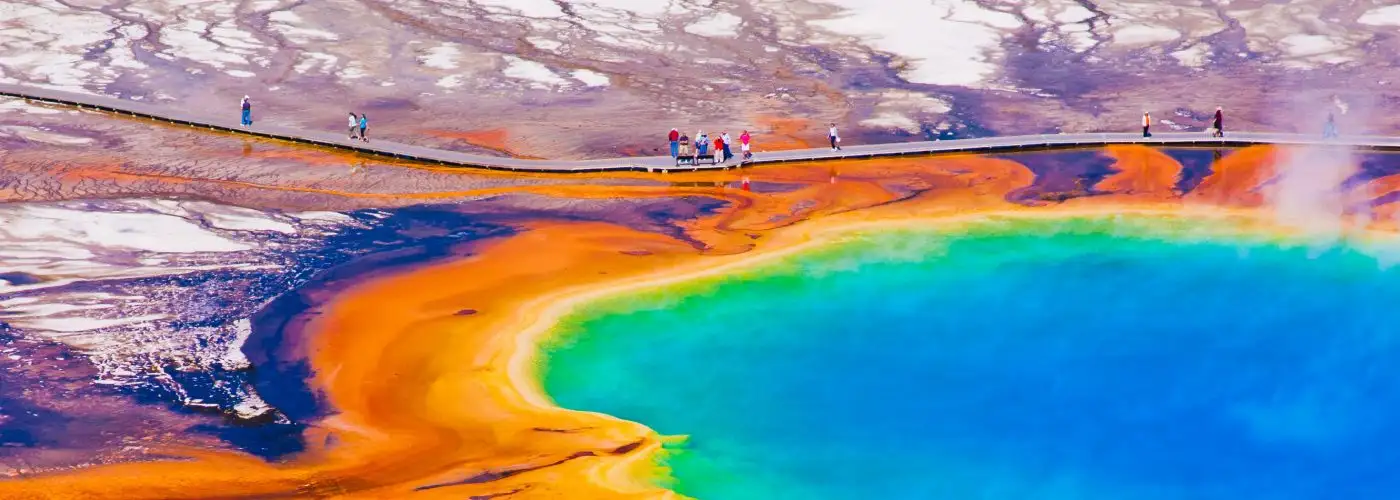Why Yellowstone National Park Is Amazing
This is where it all began, 144 years ago when Congress declared Yellowstone the first national park—a noble model that launched what author Wallace Stegner famously called “the best idea we ever had” and that has since spread to almost 100 countries worldwide.
Yellowstone’s nearly 2.2-million acres sprawls across the northwestern corner of Wyoming and into parts of Idaho and Montana, containing an astounding half of the world’s geothermal features—geysers, fumaroles, mud pots, and hot springs—that undergo subtle changes nearly constantly due the high level of seismic activity here. The tallest geyser in the world is in Yellowstone: Steamboat Geyser is capable of shooting water more than 300 feet into the air.
Icy cold Yellowstone Lake is the largest lake above 7,000 feet in North America; the lake empties into the Yellowstone River, where it meanders through the Hayden Valley before plunging into the Grand Canyon of the Yellowstone, a 20-mile, thousand-foot-deep gorge famous for its spectacular Lower Falls, which are almost twice as high as Niagara Falls.
Yet even with such marquee attractions as Old Faithful geyser, the travertine-terraced Mammoth Hot Springs, and the brilliant rainbow colors of Grand Prismatic Spring, Yellowstone is just as popular for its unusually accessible wildlife, including bear, wolves, bison, elk, and moose, who seem to largely tolerate or ignore the hordes of camera-toting tourists.
Why June Is the Perfect Time to Go
The park is most popular in July and August—and in this centennial year Yellowstone is bracing for a record number of visitors—so if you’re looking to avoid crowds as much as possible while still taking advantage of warmer weather, June is a very good choice.
Snow, especially at higher elevations, isn’t unusual, but the days are often comfortable enough for shorts and T-shirts (though it’s still a good idea to bring warm, dry layers just in case). Be sure to keep your camera close, because June is prime time for viewing the park’s youngest residents. Bear and wolf cubs, bison and elk calves, and bighorn lambs are just some of the baby wildlife you’re likely to spot. But for your good and that of the animals, keep in mind that you’re not permitted to be any closer than 100 yards from bears and wolves, and 25 yards away from other animals.
Why It’s Great at Other Times of Year
Fall can be an especially good time to see many animals, such as bears, when they come down from the mountains (which may already be covered with snow) to search for food before winter sets in. By September, the elk have usually begun rutting, which you can often see around Mammoth Hot Springs. In wintertime, the interior roads and all but the north entrance to the park are closed; but this is a particularly magical time in the park. (Always call ahead to check on the most current road conditions.) Solitude seekers can snowshoe or cross-country ski past steaming geysers and hot pots, or apply for a snowmobile permit to explore more of the park. Xanterra, the park’s concessionaire, offers guided snowcoach and bus tours.
If You Go, Don’t Miss
Understandably, most visitors will try to hit as many top spots as possible—including Old Faithful, Mammoth Hot Springs, Artists Paint Pots, and the Grand Canyon of the Yellowstone—driving the 142-mile Grand Loop Road. But you’ll find a much quieter experience if you take the time to walk any of the park’s numerous trails. The Lamar River Trail, for example, is a 20-mile (one way) out-and-back trail that gets you away from the traffic jams of the Lamar Valley. It’s recognized as one of the best places in the entire park to see animals. You don’t even have to walk the entire trail—even hiking a few miles out will put you out of range of the crowds but still close to the wildlife.
June Bonus Pick: Badlands National Park
This otherworldly landscape seems to appear almost out of nowhere as the vast Great Plains in southwest South Dakota suddenly give way to the weathered spires, buttes, pinnacles, and gullies of Badlands National Park. Wind and water have been at work for 500,000 years here, carving through the soft sedimentary rock to reveal layers laid down over millions of years in shades of ochre, red, tan, and brown. The Badlands are also home to one of the country’s largest native mixed-grass prairies, which surround the formations and offer refuge to wildlife including bighorn sheep, bobcats, white-tailed deer, prairie dogs and the endangered black-footed ferret.
More from SmarterTravel:
- Olympic National Park: Our May National Park of the Month
- Great Smoky Mountains: Our April National Park of the Month
- Hot Springs: Our March National Park of the Month
- Death Valley: Our February National Park of the Month
- Everglades: Our January National Park of the Month
Deb Hopewell is a longtime journalist and the former editor of Yahoo Travel. She writes for Outside, Fodor’s, Architectural Digest, Travel+Leisure, Yahoo Travel, and others. Follow her on Instagram @debhopewell and Twitter @dhopewell.
We hand-pick everything we recommend and select items through testing and reviews. Some products are sent to us free of charge with no incentive to offer a favorable review. We offer our unbiased opinions and do not accept compensation to review products. All items are in stock and prices are accurate at the time of publication. If you buy something through our links, we may earn a commission.
Related
Top Fares From Dayton, OH
Today's Top Travel Deals
Brought to you by ShermansTravel
Shop and Save with Country Inns...
Patricia Magaña
 Hotel & Lodging Deals
Hotel & Lodging Deals
$229 -- Chicago: Discounted Rates and...
Francesca Miele
 Hotel & Lodging Deals
$229+
Hotel & Lodging Deals
$229+
$188 -- Honolulu: Save on Oceanview...
Abigail Lamay
 Hotel & Lodging Deals
$188+
Hotel & Lodging Deals
$188+




